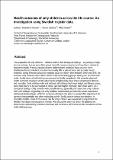Files in this item
Health outcomes of only children across the life course : an investigation using Swedish register data
Item metadata
| dc.contributor.author | Keenan, Katherine Lisa | |
| dc.contributor.author | Barclay, Kieron | |
| dc.contributor.author | Goisis, Alice | |
| dc.date.accessioned | 2020-05-20T12:30:05Z | |
| dc.date.available | 2020-05-20T12:30:05Z | |
| dc.date.issued | 2020-01-31 | |
| dc.identifier.citation | Keenan , K L , Barclay , K & Goisis , A 2020 ' Health outcomes of only children across the life course : an investigation using Swedish register data ' MPIDR working papers , no. 004 , vol. 2020 , Max Planck Institute for Demographic Research , Rostock, Germany . https://doi.org/10.4054/MPIDR-WP-2020-004 | en |
| dc.identifier.other | PURE: 268058500 | |
| dc.identifier.other | PURE UUID: cd492749-09dd-40c6-97c4-966a710926ea | |
| dc.identifier.other | ORCID: /0000-0002-9670-1607/work/74510389 | |
| dc.identifier.uri | https://hdl.handle.net/10023/19970 | |
| dc.description.abstract | The proportion of only children – children with no full biological siblings – is growing in high-income settings, but we know little about their life course outcomes and how this is related to long-term health. Previous studies of only children have tended to focus on short-term, developmental and intellectual outcomes in early life or adolescence, and provide mixed evidence. Using Swedish population register data on children born between 1940 and 1975, we compare only children with children from multi-child sibling groups, taking into account birth order, family size and half-siblings to account for family complexity. We consider physical health outcomes measured at late adolescence (height, body mass index and physical fitness), and mortality. Only children with and without half-siblings had lower height and fitness scores, were more likely to be overweight or obese, and had higher mortality, than those with 1 or 2 biological siblings. Only children without half-siblings generally did better than only children with half-siblings, suggesting that only children experiencing parental disruption experience additional disadvantages. With the exception of height, the patterns persist after adjustment for parental characteristics and after employing within-family cousin comparison designs. In mortality models, some of the excess risk for only children was explained by adjustment for fertility, marriage and educational history. We discuss the extent to which the patterns we observe are explained by selection processes and contextual differences in the prevalence of one-child sibling groups. | |
| dc.format.extent | 45 | |
| dc.language.iso | eng | |
| dc.publisher | Max Planck Institute for Demographic Research | |
| dc.relation.ispartofseries | MPIDR working papers | en |
| dc.rights | Copyright © 2020 The Author(s)/Publisher. | en |
| dc.subject | G Geography (General) | en |
| dc.subject | HM Sociology | en |
| dc.subject.lcc | G1 | en |
| dc.subject.lcc | HM | en |
| dc.title | Health outcomes of only children across the life course : an investigation using Swedish register data | en |
| dc.type | Working or discussion paper | en |
| dc.description.version | Publisher PDF | en |
| dc.contributor.institution | University of St Andrews. School of Geography & Sustainable Development | en |
| dc.identifier.doi | https://doi.org/10.4054/MPIDR-WP-2020-004 |
This item appears in the following Collection(s)
Items in the St Andrews Research Repository are protected by copyright, with all rights reserved, unless otherwise indicated.

